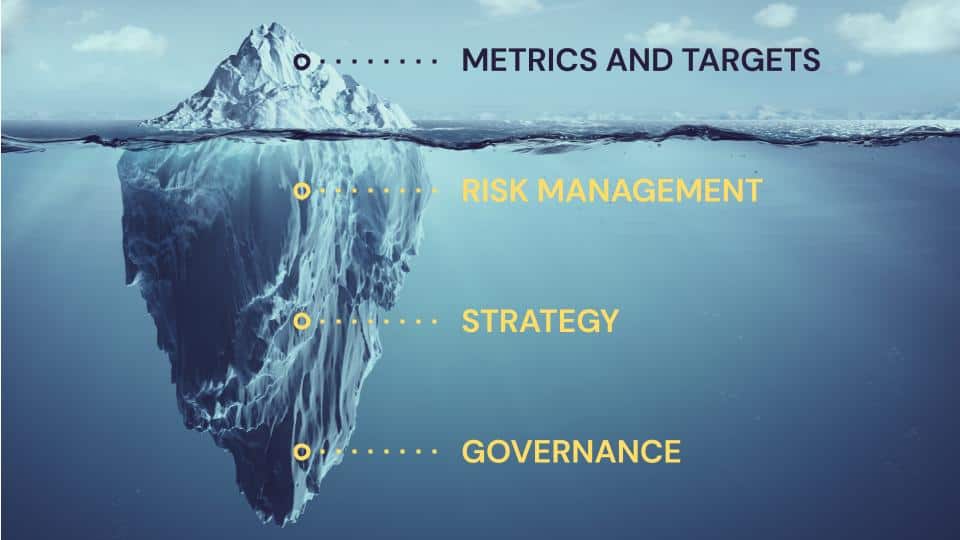In our previous blog, we outlined, at a high-level, what it means to operationalize the TCFD framework within a company. We illustrated how developing corporate-level TCFD-aptitude can start with asking some pointed questions. The right questions will reveal whether the company’s internal and external stories on climate change match and whether the climate-related disclosures of a company are sufficiently detailed to help investors make informed investment decisions. We considered some of these questions on our webinar on good climate governance.
In this Part II, we look closer at the governance foundations that are critical to unlocking the power of the TCFD. We unpack specific principles on good corporate governance that a company can apply to realize its most effective climate response, and improve its alignment with the TCFD.
Unlocking the Power of the TCFD
We’ve said before that the foundation of good corporate stewardship on climate starts with governance. And the power of the TCFD helps frame what “good” governance looks like.
When companies think of action on climate change, it is tempting to turn immediately to metrics and targets, which is one of the four pillars of the TCFD. What is our carbon footprint? When should we achieve net-zero? Should we have interim targets? (The answer to the last question, by the way, is “yes”.)
But metrics and targets can be the wrong place to start, or at least an ineffective place to start. By way of analogy, the International Energy Agency’s (IEA) report, Net Zero by 2050 (A Roadmap for the Global Energy Sector), which we discussed on a recent webinar, records that the number of countries that have pledged to achieve net-zero emissions now covers around 70% of global emissions of CO2. However, the IEA also cautions that most pledges are not yet underpinned by the policies and measures necessary to implement those net-zero pledges. Put differently, countries have committed to action, but haven’t (yet) developed the tools necessary to complete the job. This is the country-equivalent of a company committing to net zero without having effective governance in place.
Metrics and targets are like the tip of an iceberg. In a corporate context, it is impossible to give effect to the laudable ambition that underpins a net-zero target without first – or at least in parallel – developing the right corporate practices to support them. Just like an iceberg, whose stability derives from the 90% of its mass that sits below the waves, realizing a net-zero ambition is only possible if a company has completed the hard yards to operationalize the other three pillars of the TCFD, i.e. appropriate risk management processes, sound strategic direction and good climate governance.

Seen in this way, the traditional four pillars of the TCFD, which are typically shown as a series of unevenly-placed concentric circles, can be reimagined as an iceberg where form stability derives principally from good corporate practices.
Good Climate Governance – Principles and Self-Assessment
There is no single best way to set up the corporate practices that are necessary to underpin a successful corporate response to climate change; there are too many variables in geography, sectors and industries for that. There are, however, a number of principles that have universal application, and which can be used both as signposts for action, and a marker to help a company self-assess where it is on its climate journey. Here are seven categories for a company board to consider.
1. Oversight and accountability
Recognize that the board is accountable for the organization’s long-term response and resilience to climate change. Commit to this accountability both individually and organizationally. Have a clear understanding of fiduciary and other duties, and consider reporting lines. Ensure that those to whom roles and responsibilities have been delegated (see below) have a corresponding duty to report on them.
2. Roles and responsibilities
Outline and delegate responsibility within the company for climate actions, decisions, and monitoring. Ensure that all those to whom roles and responsibilities have been delegated are aware of the impact that the company’s climate strategy has on their respective roles and responsibilities. Know that people at all levels of seniority within the organization have a role to play in advancing the climate strategy. Collaborate to effect efficiency. Document results.
3. Incentives
Incorporate climate change performance elements into executive remuneration, and reward good climate stewardship. Identify misaligned incentives as soon as possible. Understand the impact of positive feedback loops and humanize the link between climate risks/opportunities and financial risks/opportunities. Use case studies to illustrate how a positive corporate impact on climate can reap both business and individual reward.
4. Knowledge and expertise
Understand the climate-related skills and knowledge within the organization. Know where to access the expertise and information needed to implement your decarbonization pathway where there is insufficient capacity in-house. Access those skills. Talk about successes and challenges. Help each other avoid duplication of efforts and ensure the organization is speaking in a common language.
5. Climate strategy
Establish a climate strategy that sets a clear organizational course and represents a shared vision for identifying and managing climate risks and opportunities. Centralize overall stewardship of the climate strategy, but empower all corporate stakeholders to disseminate and give effect to that strategy. Ensure the climate strategy is aligned to the organization’s other objectives, goals and policies. Identify areas of potential conflict and address them.
6. Risks and opportunities
Use all tools available to the organization to identify, assess and manage risks and opportunities. Use, but do not be overwhelmed by, data; data alone cannot achieve climate ambition. Consider all options, but determine which options will have the greatest return on CO2e reduction, climate resilience or climate opportunities. Do not forget opportunities; the IEA projects that decarbonization can have a positive impact on GDP.
7. Shared tools and processes
Recognize the importance of using consistent tools and processes. Establish an agreed-upon and consistent approach to the use of those tools and processes (including checklists, forms, methodologies, etc.). Ensure there are protocols in place to support the evolution of climate tools, including exploring new options. Monitor the use and effectiveness of tools and processes.
How Manifest Climate can help
The power of the TCFD lies not just in its ability to improve transparency on climate-related risks and opportunities; it’s also a framework for action generally. Put differently, a company will be better off, even if it has never disclosed anything on climate, by implementing the TCFD-derived governance principles described in this blog. And once it sets those foundations in place, it becomes far easier to build and implement a good net-zero strategy, which is both credible and effective.
Whether you work for a company that’s looking to accelerate its pathway to decarbonization, or an investor looking to make your investment decisions a little easier, call us. We can help. We’ll work with you to turn these principles into action. Contact us today.

